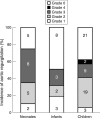Aortic balloon dilatation for congenital aortic stenosis: report of 90 cases (1986-98)
- PMID: 10573506
- PMCID: PMC1729224
- DOI: 10.1136/hrt.82.6.e10
Aortic balloon dilatation for congenital aortic stenosis: report of 90 cases (1986-98)
Abstract
Objective: To review 12 years of experience of balloon aortic valvoplasty in childhood.
Design: Early and mid-term clinical and instrumental evaluation of 104 consecutive balloon aortic valvoplasties performed from 1986 to 1998.
Setting: A tertiary referral centre for congenital heart disease.
Patients: 90 patients with congenital aortic stenosis: 20 neonates (group 1), 16 infants (group 2), and 54 children (group 3).
Interventions: Balloon aortic valvotomy.
Main outcome measures: Doppler and peak to peak aortic gradient before and after valvoplasty, degree of aortic regurgitation before and after valvoplasty, early and late mortality, need for repeat intervention or surgery.
Results: Balloon aortic valvoplasty produced a gradient reduction of > 50% in 59 patients, 12 having a residual peak to peak gradient of > 50 mm Hg. Early mortality included three procedure related and six procedure unrelated deaths. There were no intraprocedural deaths. Grade III aortic regurgitation occurred in 20 patients. Five non-lethal complications occurred. At a mean follow up of 5.1 (group 1), 5.7 (group 2), and 7.6 years (group 3), survival was 75%, 88%, and 96%, respectively. Redilatation was performed in three patients in group 1, one in group 2, and 10 in group 3. Surgery was necessary for six in group 1, one in group 2, and eight in group 3. Freedom from events at last follow up was 50%, 75%, and 64%, respectively. There was a residual maximum Doppler gradient of < 30 mm Hg in 22 patients and > 60 mm Hg in 23; 50 patients have mild to moderate aortic regurgitation.
Conclusions: Balloon aortic valvoplasty is effective and repeatable and offers good palliation for congenital aortic stenosis in childhood.
Figures




Similar articles
-
Balloon aortic valvoplasty in paediatric patients: progressive aortic regurgitation is common.Heart. 2004 Jan;90(1):77-81. doi: 10.1136/heart.90.1.77. Heart. 2004. PMID: 14676250 Free PMC article.
-
Long term results of percutaneous balloon valvoplasty of congenital aortic stenosis: independent predictors of outcome.Heart. 2004 Jan;90(1):70-6. doi: 10.1136/heart.90.1.70. Heart. 2004. PMID: 14676248 Free PMC article.
-
Balloon dilatation of the aortic valve after previous surgical valvotomy: immediate and follow up results.Br Heart J. 1994 Jun;71(6):558-60. doi: 10.1136/hrt.71.6.558. Br Heart J. 1994. PMID: 8043338 Free PMC article.
-
[Mid-term results of balloon percutaneous valvuloplasty in the treatment of aortic valve stenosis in children and adolescents].Arch Mal Coeur Vaiss. 1993 May;86(5):563-9. Arch Mal Coeur Vaiss. 1993. PMID: 8257265 Review. French.
-
Critical aortic stenosis in early infancy: surgical treatment for residual lesions after balloon dilation.Ann Thorac Surg. 2005 Jan;79(1):47-51; discussion 51-2. doi: 10.1016/j.athoracsur.2004.02.120. Ann Thorac Surg. 2005. PMID: 15620912 Review.
Cited by
-
Balloon aortic valvoplasty in paediatric patients: progressive aortic regurgitation is common.Heart. 2004 Jan;90(1):77-81. doi: 10.1136/heart.90.1.77. Heart. 2004. PMID: 14676250 Free PMC article.
-
Aortic stenosis: the spectrum of practice.Pediatr Cardiol. 2006 Nov-Dec;27(6):661-9. doi: 10.1007/s00246-006-1415-z. Epub 2006 Nov 16. Pediatr Cardiol. 2006. PMID: 17111288
-
Rapid right ventricular pacing is an alternative to adenosine in catheter interventional procedures for congenital heart disease.Heart. 2004 Sep;90(9):1047-50. doi: 10.1136/hrt.2003.025650. Heart. 2004. PMID: 15310698 Free PMC article.
-
The importance of hybrid stage I palliation for neonates with critical aortic stenosis and reduced left ventricular function.Pediatr Cardiol. 2015 Apr;36(4):726-31. doi: 10.1007/s00246-014-1074-4. Epub 2014 Dec 6. Pediatr Cardiol. 2015. PMID: 25480352
-
Long term results of percutaneous balloon valvoplasty of congenital aortic stenosis: independent predictors of outcome.Heart. 2004 Jan;90(1):70-6. doi: 10.1136/heart.90.1.70. Heart. 2004. PMID: 14676248 Free PMC article.
References
MeSH terms
LinkOut - more resources
Full Text Sources
